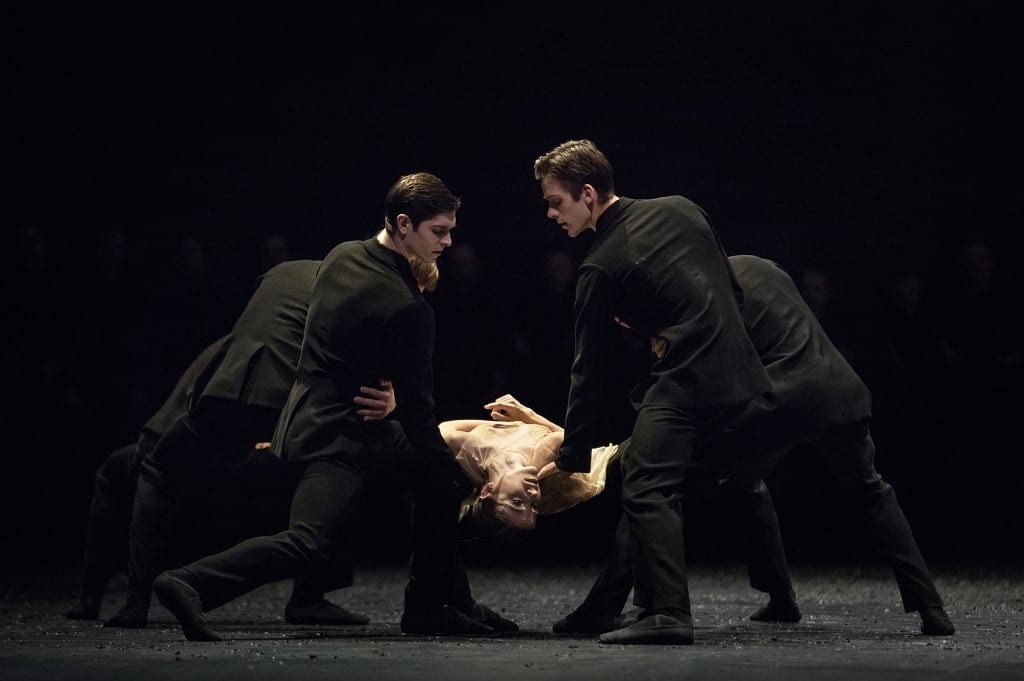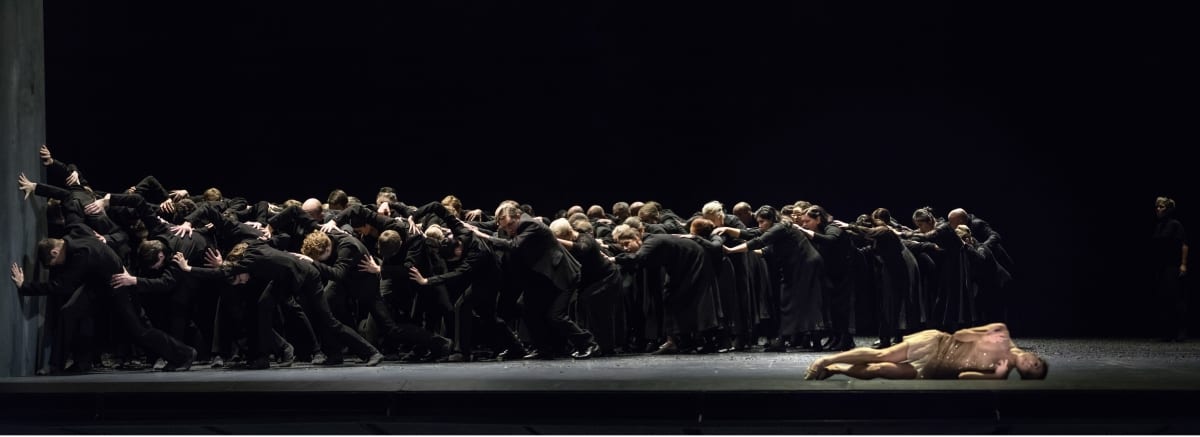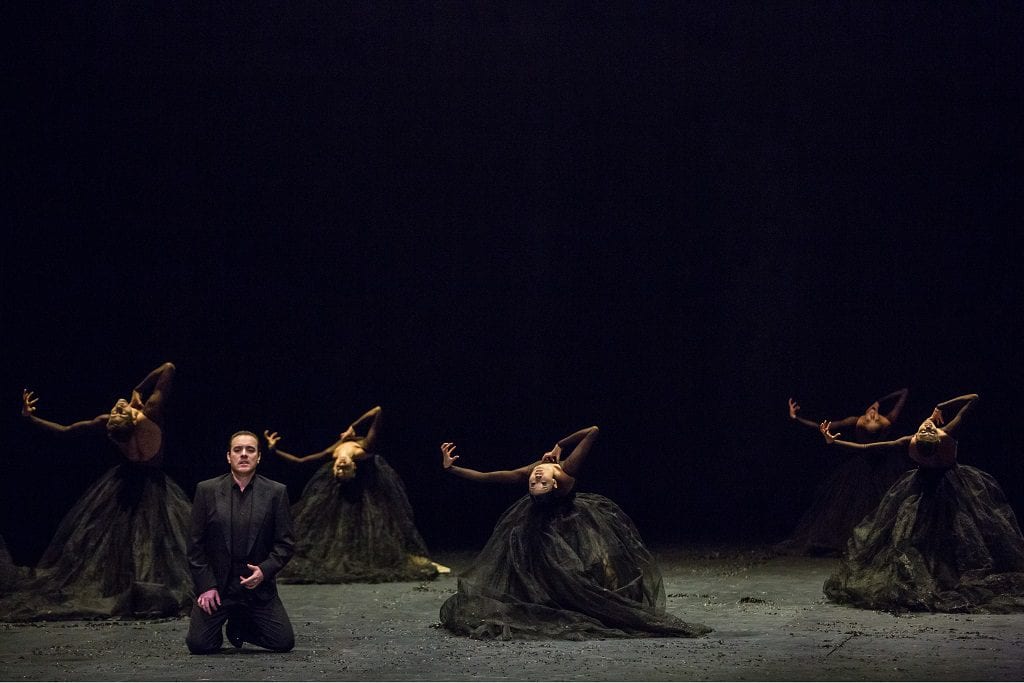Recent years have seen a growing number of oratorios, cantatas, and song cycles explored for their theatrical potential on stage, involving a range of scenographic and gestural approaches. Verdi’s Messa da Requiem, with its many operatic impulses, has been staged by the Deutsche Oper (2006) and Oper Köln (2011). In this rich and varied performance context Christian Spuck’s fully choreographed production of Verdi’s Requiem at the Opernhaus Zürich achieves an unparalleled degree of synergy and penetrating musical effect through its focus on corporeality, and its absence. Combining the resources of Ballett Zürich with an augmented chorus and stellar quartet of soloists all off book, Spuck probes various dimensions of the human condition in the face of death. As experienced on New Year’s day, when many people take stock and imagine how the world might become a better place, the performance resonated poignantly with broader struggles, with Karina Canellakis leading the Philharmonia Zürich in an impressively nuanced performance.
Verdi’s score is itself constructed so as to give voice to individuals, small ensembles, and the larger collective. So does Spuck’s handling of the dancers and singers, but not in mirror fashion. Already in the opening choreographed sequence, which takes place in silence, there is a fertile counterpoint at work. In Christian Schmidt’s dark, boxed set, strewn with ashen earth, the chorus forms shadowy mounds on each side as a pair of dancers becomes visible at the very back of the stage. The female figure struggles with the boundary of the wall, supported by her male partner but ultimately lifted high and held against it in a way that could suggest the trace of a homicide victim, a pinned insect, or a kind of crucifixion. A single female dancer at the front of the stage meanwhile expresses isolation and fear, with the opening muted celli entering the soundscape almost unnoticed. After the chorus begins, the vocal soloists emerge from the masses, all dressed in modern black garb (costumes by Emma Ryott), while their natural demeanor further characterizes each of them as “one of us.”
The chorus suddenly becomes fully mobile during the “Dies irae,” magnifying the disruptive force of the music as they race back and forth across the stage. Clearing back to line the walls, they expose a nearly naked male figure smeared with earth, whose angular, even animalistic gestures contribute strongly to the physical vocabulary of the piece. Tension builds during the trumpets’ urgent exchanges with a lone woman onstage, while the chorus faces away as if unwilling to witness her fate. At the apocalyptic climax she enacts death surrounded by a group of male dancers in black. Here Spuck and Canellakis colluded with a more generous fermata than is usually taken, opening up time to absorb the impact of this moment while forging an organic link to the ensuing bass solo “Mors stupebit,” sung by Georg Zeppenfeld, which itself contains much reflective space. From this stage forward, moments of interaction between the vocal soloists and the growing body of dancers deepen the sense of community, as do domino-like waves of choreographic gestures and dramatic formations involving all of the performers. The mezzo-soprano role is shaped as an especially sympathetic intermediary, and thus it was greatly appreciated that Veronica Simeoni acted the role while vocally indisposed; at short notice Alisa Kolosova sang the part, exquisitely and mostly from the side of the stage.
A more sublime treatment of the physical dimension emerges just before the soprano/mezzo-soprano “Recordare” duet. As the repeated plea “salve me” dwindles to a whisper, a solo female dancer is raised up high–a limp figure whose chest reaches upward through the support of her partner. This potent image returns in multiplied form toward the end of the work, during the “Libera me.” The “Recordare” itself features dances that freshly profile a classical kind of beauty. Later, Spuck exploits the tension underlying the tenor solo “Ingemisco,” sung by Francesco Meli and set off by another generous pause. Women (and a couple of men) enter wearing full-skirted, barebacked black gowns, their faces turned away from the audience. Skeletally-etched backsides and contorted hands convey persistent angst despite the tenor’s fleeting grasps at hope. By contrast, the sense of painful lament is forcibly suppressed during the “Lacrymosa,” when a more concealing version of the black dress comes into play. This allusion to dance in nineteenth-century opera, with the male performers formally dressed and the women on pointe in a tightly controlled depiction of beauty, evokes more than a hint of social critique.
An important turning point takes place during the Offertorio. Soprano Krassimira Stoyanova admirably navigated the daunting octave and a half span of her reference to Michael as a potential bearer of holy light, which in turn effects a positive transformation in an agitated solo female dancer. The confining set then lifts to let in a rim of light before the Sanctus unfolded as unbridled jubilation, with the chorus showing self-awareness. Dancers Yen Han und Filipe Portugal achieve an extraordinary lightness and fluidity stained by sadness during the Agnus Dei, which prepares the way for the Lux aeterna movement, when the dancers appear natural and relaxed for the first time, wearing a mixed palate of colours. The bass’s inevitable recollection of the opening prayer “Requiem aeternam dona eis” is an unwelcome intruder, while the soprano’s entrance in the distinctive black dress (she has worn a pantsuit until this point) underscores the more archaic and operatic dimensions of the work.
Is the collective voice now under threat? Is peace but a mirage? The net effect of what might be understood as a belief in liberation combined with this darker pull might be sensed in the movements of some of the dancers–striving or fleeing gestures scaled backed to slow motion. And while the chorus naturally also plays a crucial role in the concluding “Libera me” movement together with the soprano soloist, everyone is sealed up coffin-like when the roof of the set descends at the end, leaving us with the image of a single lifeless body abandoned on a rooftop.
This compelling and ambitious production is sold out for its remaining performances, but Swiss television will broadcast a 50-minute documentary charting its development on April 14, 2017, when it will also make available an audio-visual recording of a full performance on srf.cd/kultur, viewable for four weeks. The production has also been recorded for release on DVD in the fall.



